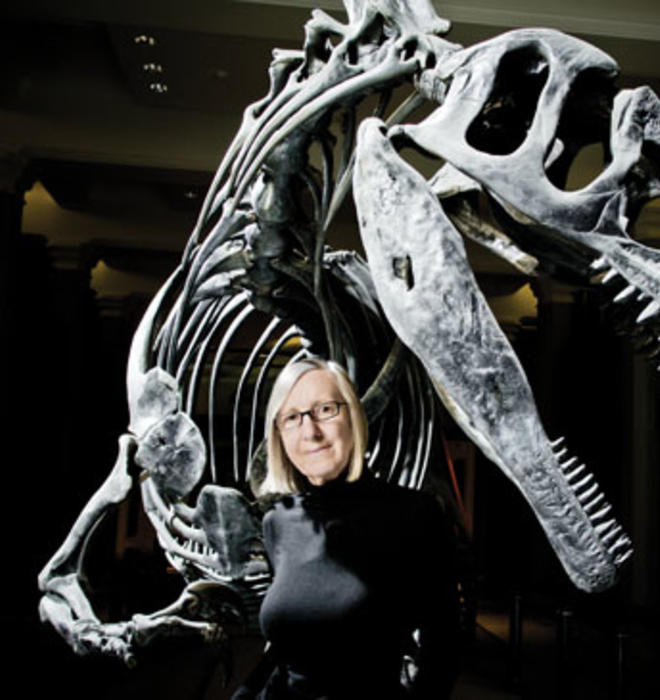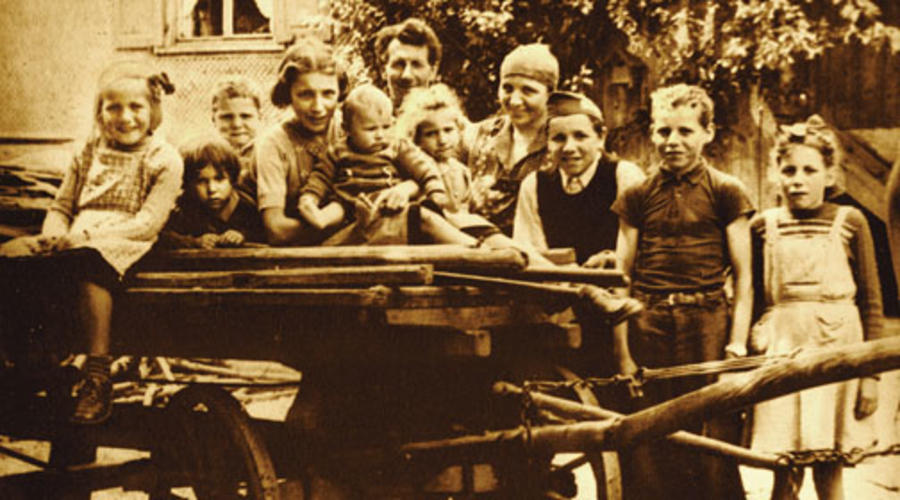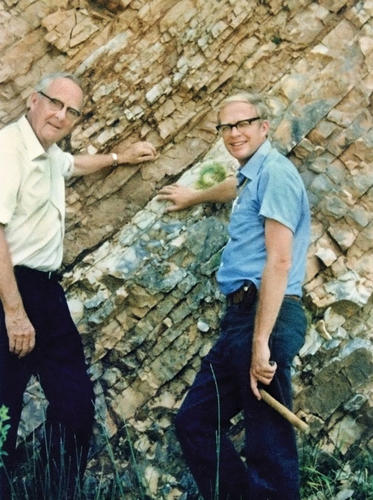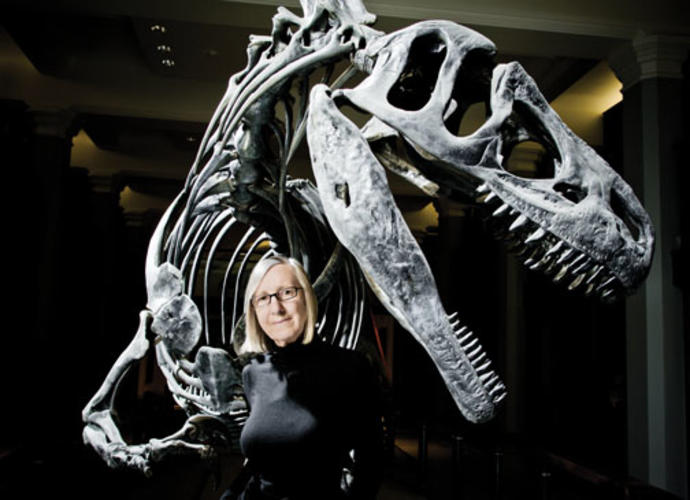
THE SEPIA-TINTED PHOTOGRAPH shows a farm family in Switzerland a few years after the end of World War II. There’s a mother, a father, and a swarm of children. The family eventually will have a dozen kids, six boys and six girls, plus 18 cows and a dozen pigs and some workhorses. In the photo they pose next to a wagon. The girls wear aprons to protect their hand-sewn clothes from getting soiled. They’re poor. It’s a pastoral but cramped existence, the horizon limited by poverty and, for the girls especially, a social code that tells them they can dream of little more than being a nurse or a seamstress.
In the photo, most of the children look wary; some smile timidly. But one little girl, on the left side of the frame, smiles broadly for the camera. She occupies a special position, at the edge of the group, sitting on the wagon, and one can sense her independence.
“I was always a bit separate from the rest,” says Gerta Keller.
Professor Keller, that is. Her rags-to-riches story has wound up improbably on the third floor of Guyot Hall at Princeton. It has been a very long journey by way of England, North Africa, Australia (where she was shot and nearly killed by a bank robber), and San Francisco during the heyday of Flower Power. There were many way stations in the middle of nowhere, among outcroppings, riverbeds, quarries — amid the rocks that tell the story of the planet’s history. Keller is a geologist and paleontologist.
She’s also a catastrophist. Her world isn’t one of gradual, uniform change. It’s a lot more dramatic than that.
Keller, who never has let other people tell her what to do, is today one of the most controversial figures in her field. She’s an indefatigable critic of the most widely accepted theory of what wiped out the dinosaurs 65 million years ago and brought the Cretaceous Period to an end. She has a rival hypothesis, and is determined to prove she’s right.
She’s once again separate from the rest.
On a terrible day about 65.5 million years ago, a mountain-sized object from space crashed into the Earth near what is now the tip of the Yucatan Peninsula. The so-called Chicxulub (CHEEK-shoe-lube) impact, named for a Yucatan village, excavated a 110-mile-wide crater and sent a tsunami the height of a Manhattan skyscraper crashing onto the shores of the Gulf of Mexico. The impact ejected enough dust into the stratosphere to darken the planet and temporarily shut down photosynthesis. The effects were devastating, and global.
Half the genera on the planet disappeared, including the dinosaurs (or, as we are compelled to say now that we know a chicken is a distant cousin of T. rex, “the non-avian dinosaurs”). This was the most recent of the five great mass extinctions in the fossil record. The discovery of the Chicxulub catastrophe has obvious implications for our own species, which, though currently in a period of efflorescence, could discover one day that it has no more permanent sovereignty on the planet than did the giant reptiles that ruled for 150 million years.
The impact hypothesis for what’s called the K/T extinction (K for the German word for Cretaceous, T for Tertiary) dates to 1980. Geologist Walter Alvarez *67 had been doing fieldwork in the late 1970s in Gubbio, Italy, studying an outcropping that featured a thin clay layer marking the boundary between the Cretaceous and Tertiary rock formations. It was one of the best-known sites for seeing the change in the fossil record that occurred 65.5 million years ago. Below, the older rock contains fossils of numerous species of foraminifera, which are planktonic marine organisms. Above the clay layer, in younger rock, the forams, as they’re commonly called, are smaller, and represent only a few species.
Alvarez wanted to know how long it had taken for the clay layer to be deposited. An enduring mystery was whether this change in the fossil record reflected a sudden die-off or something more gradual. Sedimentary strata can be deceptive: It’s hard to know how much time is represented by any particular layer. There can also be gaps in sedimentation. Alvarez’s father, Nobel laureate physicist Luis Alvarez, suggested that it would be possible to estimate the time it took for the clay layer to be deposited by studying the quantity of iridium in the clay. Iridium is a rare element on Earth but steadily rains upon the planet from space in small quantities.
The father-son Alvarez team made a startling discovery: The clay layer contained an anomalously large quantity of iridium. This suggested a new idea: The iridium came from a large asteroid that had struck Earth.
The Alvarezes and two colleagues published their earthshaking paper, “Extraterrestrial Cause for the Cretaceous-Tertiary Extinction,” in the journal Science in 1980. There remained one obvious hole in the impact theory: Where was the crater? As it happened, in the late 1970s, geologists working for a Mexican oil company studying gravity maps off the coast of the Yucatan discovered what appeared to be a buried, eroded crater. They didn’t know if it was from a volcano or an impact. They said little about it. Throughout the 1980s, the mystery of the crater’s location bedeviled scientists, but they gradually began homing in on the Gulf of Mexico after finding what appeared to be tsunami debris in southern Texas. Finally, in 1990, they put it all together, and Chicxulub soon became known as the Crater of Doom.
Keller doesn’t dispute that there was a giant impact event at Chicxulub. But ...
“I’m an impactor, too,” she says. “It comes down to the age of the impact. Very simply, the age. It is much older than the mass extinction.”
It’s all about the timing, the sequence of events. The Chicxulub impact, she has argued, predates the extinction by roughly 150,000 to 300,000 years. She bases this on fieldwork that has taken her to 150 K/T boundary sites around the world.
So what caused the extinctions? Volcanoes, for starters, she says. Specifically, the Deccan Traps. The Deccan Traps (“traps” comes from the Swedish word for stairs) comprise a vast area of lava flows, much larger than the state of Texas and in some places more than two miles thick, on the Indian subcontinent. The main eruption occurred very close to the end of the Cretaceous period, pumping enormous quantities of sulfur dioxide, carbon dioxide, and chlorine gases into the atmosphere and causing dramatic climate change. Add to that the impact events — plural. Chicxulub wasn’t the only impact, Keller says. In her scenario, the planet endured not just one but a series of catastrophes that caused the mass extinction.
She is fighting an intellectual war in two distinct theaters — the Gulf of Mexico and India. She spends a great deal of time along the Brazos River in Texas, a key K/T boundary site. At multiple sites around the Gulf of Mexico, she says, tiny spherules from the impact are below the K/T boundary, which suggests that the impact and the extinction were separated in time. She notes that there are several locations where the spherules appear to be right at the K/T boundary, but says this is the result of erosion that has reworked the sediments. It’s a debate that is literally and figuratively granular: Most of us have no way to know if she’s right.
She says of the proponents of the Chicxulub theory: “It’s a beautiful scenario that they made. Only that it’s all wrong.”
I ask her if she thinks the Chicxulub impact had caused any extinctions whatsoever. She pauses, and looks at me steadily.
Then she says: “Not a single species.”
Her mother was the oldest of a dozen, her father the youngest of 18. She was the sixth of 12, and her mother’s confidante. She was born in Liechtenstein, just weeks before the close of the Second World War. The family soon moved just a few miles away, across the border into Switzerland. There still were military camps nearby, and the kids would go to the soldiers to ask for leftover food.
Their farm in Switzerland went on the auction block every six months or so, but there were no buyers because no one wanted to put a family with a dozen kids on the street. Eventually the government stepped in and ran the farm, giving the family an allowance.
Gerta learned to find snails, which she could sell for a few dollars a kilo.
“Even when I was 4 years old I would go all day long with two buckets to look for escargot. I would walk as much as five to 10 miles a day, all over Liechtenstein and Switzerland, and collect these white, big snails,” she says. “I loved the mountains. I would go hiking in the mountains, the forest. I didn’t pay much attention to rocks. I mostly paid attention to flowers.”
But she wanted more.
“I really longed to see the world. I was a voracious reader. I would see planes occasionally going overhead, and I would dream of what it would be like to see other places.”
In another black-and-white photo on her office wall, she’s standing by a watering trough, wearing a new, home-sewn dress. “My mother made it,” she says, “but she was a very bad seamstress. It was so tight that that was the only day I could wear it, because it tore apart. But I was very proud of that dress, the few hours it lasted.”
At 12, she decided she wanted to be a doctor. She remembers being told that she had to be realistic: “You can be a housemaid, a salesgirl, or you can be a dressmaker.”
At 14, she became an apprentice to a dressmaker. She gradually grew depressed. She started working as a waitress, saved some money, and finally, at the age of 18, hit the road. She went to England to study English. She visited North Africa, the Middle East, Eastern Europe, and Greece, and caught hepatitis along the way. She returned to Switzerland to recuperate, and then, at 20, emigrated to Australia.
One day she and a friend were returning from a trip to the beach near Sydney when they noticed that there were no other cars on the road. A man in a trench coat was running, shooting a rifle. A movie, they thought — someone’s filming a movie. Except there were no cameras. The man — a bank robber — came up to their car and demanded that they get out; then he shot Keller in the upper arm, and the bullet went through both lungs. She collapsed and her friend pulled her out of the car.
“I looked up at the sky. The whole sky seemed like a canvas. My life from my youngest days all went by. I thought, so, that’s it, this is what it’s like when you die.”
At the hospital, a priest insisted that she make a final confession.
“I have nothing to confess,” she said. She thinks her anger in that moment — her contrarian rage — saved her life.
That was 1967. She was not quite 23 years old. When she recovered, she flew with her boyfriend, Tim Callahan, to San Francisco and began to reinvent herself as a student. The counterculture was in full flower. She married Callahan — the union would last four years — and started taking college classes, first at City College, then graduating from San Francisco State. She was obviously bright, and determined, and she won over the geologists at Stanford, who accepted her as a Ph.D. candidate in 1973.
Sometimes, though, she got on people’s nerves. The field was dominated by men, some of whom were not accustomed to dealing with a strong-willed woman.
“She’s very stubborn, independent, not afraid to express her opinion,” says John Barron of the U.S. Geological Survey, who knew her in the 1970s. “She’s just so much different from what women were at that time.”
He adds: “She once told me that ‘Gerta’ was the spear wielder in German. She has certainly lived up to her name.”
Geology is a field that gets shaken up regularly. When Alfred Wegener proposed his theory of continental drift early in the 20th century, few people took him seriously. There simply was no way that something as huge as a continent could plow through the crust of the Earth, it seemed. Now, in revised form, continental drift is the orthodoxy; it’s impossible to discuss the history of the Earth without referring to plate tectonics — a theory developed to a significant extent at Princeton in the 1960s under the leadership of geology department chairman Harry Hess *32.
The Alvarez theory, likewise, redeemed the musty, pre-scientific notion that the Earth’s history has been shaped by catastrophic events. The field of geology in 1980 long had been dominated by the doctrine known as uniformitarianism. First promulgated by James Hutton and Charles Lyell in the 18th and 19th centuries, this was the belief that the planet had changed very gradually over long periods of time, an idea boosted by the discovery of Darwinian natural selection.
This is a field, it seems, where there is rarely anything that might be called a settled fact. It’s innately interpretive. Geologists work with broken, eroded, baked, compressed, and very old material. Rocks don’t speak. There always will be arguments about what the geological record is trying to say. “Geological data are messy, by necessity. There is always a devil in paradise,” Jan Smit, one of the originators of the K/T impact hypothesis, has written.
So it was that, as the Alvarezes’ impact theory was being developed, there remained skeptics such as Keller. Even after the discovery of the Crater of Doom, hailed as a smoking gun for the impact, a number of scientists challenged the orthodoxy. Two of the most prominent were professors at Dartmouth, Charles Officer and Charles Drake, both of whom preferred the Deccan Traps as the killing mechanism.
Keller was a bit late to get into the debate (“I didn’t want to jump on a bandwagon like everyone else,” she says). It was only in the mid-1980s that she dove in, first at a conference at Snowbird, Utah, where, as she recalls, she was such an unknown that she was introduced as “George.” She presented slides, based on her study of the K/T boundary, indicating that the extinction didn’t happen in one instant but rather over a broader period of time. A line quickly formed as one scientist after another wanted to take issue with her argument.
“That was considered incredibly heretical and I was attacked unbelievably,” she says. “It was almost pandemonium at the end.”
She recalls a colleague coming up to her at lunchtime, saying, “Gerta, you should know when you should shut up. You have to be more diplomatic.” Her response: “I can’t shut up if it’s so untrue what they’re saying.”
Keller has suggested that the mass extinction came from a one-two punch: The volcanic eruptions changed the climate, and weakened species then were finished off by a meteorite impact — though not the one at Chicxulub. She co-authored a study reporting signs of a meteorite strike in India from the time of the mass extinction. Such an impact could explain the iridium found at the K/T boundary, she says. Or perhaps the iridium came from volcanism bringing material from deep within the Earth. “I can’t say one way or another,” she says. But she’s convinced that the Chicxulub impact didn’t cause the K/T iridium anomaly or the mass extinction.
Over the years she has argued her case tirelessly, and has gained some allies. Volcanism has acquired new scrutiny as a possible cause of mass extinctions. The worst mass extinction in the fossil record, at the end of the Permian — the last period of the Paleozoic Era — seems to have coincided with massive volcanic eruptions.
“Her opponents have failed to adequately address the issues she has raised, and often choose to ignore her work because — to paraphrase a phrase from elsewhere — what she has discovered are inconvenient truths that cast severe doubt on a model that they have been peddling,” says Andrew Kerr, a petrologist at Cardiff University in Wales who supports Keller.
Ted Nield, editor of the journal Geoscientist and author of the book Incoming!, which features a chapter on Keller, says, “Gerta is the sort of person for whom universities were created — and for whom the protection of tenure is so vital. She has had the guts and determination to stand out against an unstoppable bandwagon that itself started off as heresy but which has quickly become a rather oppressive orthodoxy.”
Is she right? Nield says he can’t say. But he finds Keller to be a compelling figure — and has written about her despite criticism that she doesn’t deserve the attention.
The impact theory for the K/T mass extinction isn’t universally acepted, but any rival hypothesis carries the heavier burden of proof at this point. The impact theory is based on multiple lines of evidence at both the macroscopic and microscopic level. It also has the lovely feature of parsimony. It’s not very complicated. In science, simpler is usually better. And if a giant rock hit the Earth very close to the time that all the dinosaurs disappeared, it’s hard to think of that as a mere coincidence and not a matter of causality.
But you can say the same thing about the Deccan Traps.
The K/T event, says Paul Wignall of the University of Leeds, “qualifies as the biggest coincidence in world history — peak volcanism coincided with the impact of the largest meteorite to hit in the past billion years.”
The K/T extinction controversy shows no sign of abating more than 30 years after the Alvarez paper was published. In a 2010 review of the issue in Science, German geophysicist Peter Schulte and 40 co-authors declared flatly that the Chicxulub impact alone triggered the mass extinction. The scientists said multiple lines of evidence, including the pattern in which material had been ejected from the crater, place the impact at the K/T boundary. Deccan volcanism, they wrote, would have resulted in “only moderate climate change” during the last 400,000 years of the Cretaceous.
That article stirred the pot again, and a number of scientists published letters to Science objecting to the case-closed conclusion of Schulte and his co-authors, and arguing for multiple causes of the extinction. Keller also weighed in, reiterating her argument, in a letter, that Chicxulub predates the K/T boundary and that Deccan volcanism could have had as dire an effect on global climate as the impact event.
Keller says of her critics, “The reason they cannot accept it is because it would mean they would have to admit that their theory was wrong.” Few people, she says, could admit that for 20 years, “they’ve been preaching up the wrong tree.”
She adds, “That’s probably a wrong way of saying it.”
“Barking,” I suggest. Barking up the wrong tree.
She laughs, and says, “I once said, ‘You can kill this bird with two stones.’”
Keller is now 67, a successful renegade. She’s been married for three and a half decades to the New York University mathematician Andrew Majda. In her third-floor office in Guyot Hall, ornamental plants — jade, euphorbias, bougainvillea, Christmas cactus — bask in the sunlight streaming through tall windows. She has antique filing cabinets and chairs, rescued from one of the department’s overhauls some years back. Her shelves are filled with books and manila folders, hardly a square inch unoccupied.
“It’s a crazy life, but it’s the best I could do,” she says.
She chose her passion well: “If you like to sit on a beach and watch the sundown, if you like to travel and experience different culture, then you should become a geologist, because you can always dream up a project involving rocks anywhere in the world, and somebody’s going to pay you for that.”
It’s easy to forget, as we discuss the events that ended the Cretaceous period, that we’re speaking of disasters, of global catastrophes. It was so long ago. It doesn’t feel, to me, completely real. I asked her if it could happen again — meaning another volcanic eruption on the scale of the Deccan Traps.
“It will happen again. Of course,” she says. “There’s nothing we can do. These eruptions are absolutely unbelievably giant. What would we do? We’re causing extinctions even without those eruptions. We’re right in the middle of one.”
There’s a subtle, slightly political element to Keller’s thesis: Her view of volcanic activity causing extinctions more gradually has an echo in the current concerns about climate change. She says of the impact scenario — the Hammer of God bringing instant catastrophe — “It’s a very sexy, beautiful theory. It appeals to everyone’s imagination. It’s simple. It absolves you from having done anything that might have caused a mass extinction.”
She draws another lesson from the forams:
“If we take the analog to these critters we are studying in the ocean, the more specialized we get, the less we are going to survive. We are specialized. Rats and cockroaches are not specialized at all. They’ve been the same for the last 250 million years. They’re going to survive. But I have my doubtswe will.”
Wow.
“It’s a comforting thought, isn’t it?” she says sarcastically.
We have lunch at Frist, and she ruminates on her status as a heretic (she can’t be described as an apostate because she never believed in the orthodoxy).
“I would prefer everyone to love me instead of hate me. But that’s not going to happen,” she says.
Hate, really? How do they manifest that, I ask.
“Stare. Some of them shout. ‘You’re wrong. You don’t know what you’re doing.’”
We then visit her lab in Guyot. I look through a microscope at some of her forams. She shows me some big ones, the diverse ones from before the K/T extinction.
“They expend a lot of energy being pretty and big,” she says.
Magnified 120 times, they look to me like little white blobs.
Through another microscope I examine the post-extinction forams. Smaller, yes. But still blobby.
“The difference is enormous, as you can see,” she says, though I find it challenging to make head or tail of these little things.
This kind of work takes a trained eye. Patience. Doggedness. These are not charismatic megafauna — they’re the size of grains of salt, or smaller. And Keller has lots of them. She has a tremendous archive of foraminifera, packaged and labeled in drawers in a room adjacent to the lab.
Whoever wins the K/T debate will not win because of a vote. Science isn’t a democracy. Yes, Keller still is regarded as a contrarian, but that may not be a permanent status. When I email my freshman-year geology professor, Ken Deffeyes *59, and ask him about Keller’s contrarianism, he writes back:
“The winner of a war gets to write the history. Gerta is a contrarian only if she loses.”
Joel Achenbach ’82 is a writer at The Washington Post.









1 Response
John Mason ’66
9 Years AgoGiving nurses short shrift
Re “The dissenter” (cover story, June 11): I do not like the phrasing “little more than being a nurse” — it sells Florence Nightingale a little short. Your readers may find themselves glad of a nurse one day.